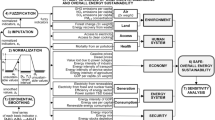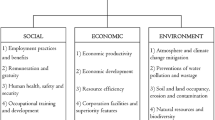Abstract
A vital part of sustainable development is the provision of adequate, reliable, and affordable energy, in conformity with social and environmental requirements. Energy is one of the most crucial factors that power modern economies subject to a volatility in price and supply, while at the same time it is responsible for major environmental consequences with global warming topping the list. In this chapter we develop a model that provides a general mechanism to measure the sustainability of energy sectors. Sustainability is an inherently vague concept, and for this reason the model uses fuzzy logic, which has the ability to deal with such an ambiguous, complex, and polymorphous concept. The proposed model follows the principles of SAFE (Sustainability Assessment by Fuzzy Evaluation), a model for the numerical assessment of sustainability. To consider the cumulative effects of past policies, we use exponential smoothing on sustainability data, while an imputation procedure is applied in order to overcome the problem of missing values. The model is applied to a large set of countries, which are ranked according to their sustainable energy development.
Access this chapter
Tax calculation will be finalised at checkout
Purchases are for personal use only
Similar content being viewed by others
References
Andriantiatsaholiniaina L, Kouikoglou VS, Phillis YA (2004) Evaluating strategies for sustainable development: fuzzy logic reasoning and sensitivity analysis. Ecol Econ 48:149–172
Esty DC, Levy M, Srebotnjak T, Sherbinin A (2005) 2005 Environmental sustainability index: benchmarking national environmental stewardship, New Haven: Yale center for environmental law and policy. http://www.yale.edu/esi. Accessed 31 July 2012
IAEA (International Atomic Energy Agency) (2005) Energy indicators for sustainable development: Guidelines and methodologies. International Atomic Energy Agency, Vienna
IEA (International Energy Agency) (2002) World energy outlook: energy and poverty, Paris: International energy agency. http://www.iea.org//textbase/nppdf/free/2000/ weo2002.pdf. Accessed 31 July 2012
IEA (International Energy Agency) (2010) World energy outlook 2010, Paris: International energy agency. http://www.iea.org/publications/freepublications/publication/ weo2010.pdf. Accessed 31 July 2012
IEA (International Energy Agency) (2011a) Energy balances of non-OECD countries. International Energy Agency, Paris
IEA (International Energy Agency) (2011b) Energy balances of OECD countries. International Energy Agency, Paris
IEA (International Energy Agency) (2011c) Energy statistics of Non-OECD countries. International Energy Agency, Paris
IEA (International Energy Agency) (2011d) Energy statistics of OECD countries. International Energy Agency, Paris
Kouikoglou VS, Phillis YA (2009) On the monotonicity of hierarchical sum-product fuzzy systems. Fuzzy Set Syst 160:3530–3538
Kouloumpis VD, Kouikoglou VS, Phillis YA (2008) Sustainability assessment of nations and related decision making using fuzzy logic. IEEE Syst J 2:224–236
Little RJA, Rubin DB (1987) Statistical analysis with missing data. Wiley, New York
OECD (2005) OECD factbook 2005. OECD Publications, Paris
Phillis YA, Andriantiatsaholiniaina L (2001) Sustainability: an ill-defined concept and its assessment using fuzzy logic. Ecol Econ 37:435–456
Phillis YA, Grigoroudis E, Kouikoglou VS (2011) Sustainability ranking and improvement of countries. Ecol Econ 70:542–553
Phillis YA, Kouikoglou VS, Andriantiatsaholiniaina L (2003) Sustainable development: a definition and assessment. Environ Eng Manag J 2:345–355
UNDESA (United Nations Department of Economic and Social Affairs) (2007) Energy indicators for sustainable development: country studies on Brazil, Cuba, Lithuania, Mexico, Russian Federation, Slovakia and Thailand, New York: United Nations. http://www.un.org/esa/ sustdev/publications/energy_indicators/chapter2.pdf. Accessed 31 July 2012
UNEP (United Nations Environmental Programme) (1987) Our common future: the world commission on environment and development. Oxford University Press, Oxford
World Resources Institute (2006) EarthTrends: environmental information, World resources institute, Washington, DC. http://earthtrends.wri.org. Accessed 31 July 2012
Author information
Authors and Affiliations
Corresponding author
Editor information
Editors and Affiliations
Appendix: Basic Indicators
Appendix: Basic Indicators
Definitions of indicators are taken from Esty et al. (2005), OECD (2005), IEA (2002, 2010, 2011a, b, c, d), World Resources Institute (2006), as well as from the websites of the World Bank (http://data.worldbank.org), the Environmental Sustainability Index (www.yale.edu/esi), the Human Development Report (http://hdr.undp.org), and the United Nations Environment Program (http://geodata.grid.unep.ch).
-
Greenhouse gas (GHG) emissions per capita (tons of CO2 equivalent): Emissions of total GHG (CO2, CH4, N2O, hydrofluorocarbons (HFC’s), perfluorocarbons (PFC’s), and SF6), excluding land-use change and forestry. To convert all emissions to CO2 equivalent, the global warming potential (GWP) is used. GWP is an index used to translate the level of emissions of various gases into a common measure in order to compare the relative radiative forcing of different gases without directly calculating the changes in atmospheric concentrations. GWP is the ratio of the warming caused by a substance to the warming caused by the same mass of CO2.
-
Atmospheric concentrations of NO2 and SO2 (μg/m3 of air): The values were originally collected at the city level. The number of cities with data provided by each country varies. Within each country, the values have been normalized by city population for the year 1995, and then summed to give the total concentration for the given country. High concentrations decrease air sustainability.
-
PM10 (μg/m3 of air): Particulate matter concentrations refer to fine suspended particulates less than 10 microns in diameter that are capable of penetrating deep into the respiratory tract and causing significant health damage.
-
Nuclear waste (tons of heavy metals per capita per year): Nuclear waste is primarily due to spent fuel from nuclear power plants. It is assumed that nuclear waste influences land sustainability negatively due mainly to generation of heavy radioactive metals.
-
Access to electricity (percent of population): Access to electricity is the percentage of population with access to electricity. Electrification data are collected from industry, national surveys and international sources.
-
Renewable resources production (percent of total primary energy supply): The higher the proportion of renewable energy sources is, the less a country relies on environmentally damaging sources such as fossil fuel and nuclear energy.
-
Electricity production from oil, gas, and coal sources (percent of total electricity production): Sources of electricity refer to the inputs used to generate electricity. Oil refers to crude oil and petroleum products. Gas refers to natural gas but excludes natural gas liquids. Coal refers to all coal and brown coal, both primary (including hard coal and lignite-brown coal) and derived fuels (including patent fuel, coke, oven coke, gas coke, coke oven gas, and blast furnace gas). Peat is also included in this category.
-
Energy intensity (kg of oil equivalent per $1,000 GDP - constant 2005 PPP): Energy intensity is a measure of the energy efficiency of a nation’s economy. It is calculated as units of energy per unit of GDP. High energy intensities indicate a high price or cost of converting energy into GDP. Low energy intensity indicates a lower price or cost of converting energy into GDP. Energy intensity, as defined here, should not be confused with Energy Use Intensity (EUI), a measure of building energy use per unit area.
-
Energy use (kg of oil equivalent per capita): It refers to use of primary energy before transformation to other end-use fuels, which is equal to indigenous production plus imports and stock changes, minus exports and fuels supplied to ships and aircraft engaged in international transport.
-
Energy imports (percent of energy use): Net energy imports are estimated as energy use less production, both measured in oil equivalents. A negative value indicates that the country is a net exporter. Energy use refers to use of primary energy before transformation to other end-use fuels, which is equal to indigenous production plus imports and stock changes, minus exports and fuels supplied to ships and aircraft engaged in international transport.
Rights and permissions
Copyright information
© 2013 Springer-Verlag London
About this chapter
Cite this chapter
Grigoroudis, E., Kouikoglou, V.S., Phillis, Y.A. (2013). A Fuzzy Paradigm for the Sustainability Evaluation of Energy Systems. In: Cavallaro, F. (eds) Assessment and Simulation Tools for Sustainable Energy Systems. Green Energy and Technology, vol 129. Springer, London. https://doi.org/10.1007/978-1-4471-5143-2_10
Download citation
DOI: https://doi.org/10.1007/978-1-4471-5143-2_10
Published:
Publisher Name: Springer, London
Print ISBN: 978-1-4471-5142-5
Online ISBN: 978-1-4471-5143-2
eBook Packages: EnergyEnergy (R0)




